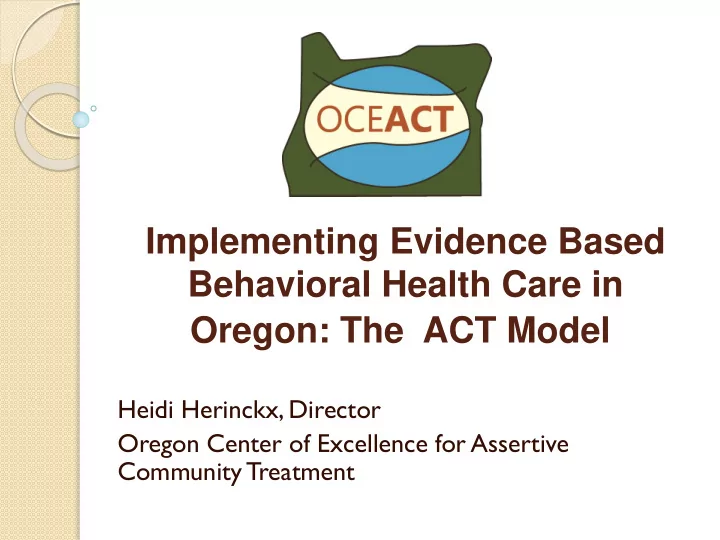

Implementing Evidence Based Behavioral Health Care in Oregon: The ACT Model Heidi Herinckx, Director Oregon Center of Excellence for Assertive Community Treatment
Why ACT?: ACT as an evidenced based practice Reducing re-hospitalizations and ER utilization Increasing housing stability Improving quality of life More independent living Better substance abuse outcomes Higher rate of competitive employment Greater consumer and family member satisfaction Higher rate of treatment retention
ACT in the Continuum of Care Less Intensive More Intensive Psychiatric Hospital Crisis Resolution Secure Residential Residential Treatment Assertive Community Treatment Intensive Case Management General Mental Health Services and Case Management Institutionalized Care Community Care
ACT: Target Population ACT is designed to serve persons with: Severe mental illness/psychotic disorders Significant functional impairments High utilization of psychiatric hospitals History of criminal justice involvement Inability to participate in traditional services or those who do not engage in any mental health services Coexisting substance abuse disorder History of homelessness
ACT Staffing Recommendations Position Large Small Micro (serves 80-100) (serves 40-80) (serves 10-39) FTE level FTE level FTE Level Team Leader (QMHP + 2 years) 1 1 .5 - 1 Psychiatrist/Psychiatric Nurse 1 .5 .25 Practitioner RN 2 1 .5 Peer Specialist 1 1 .5 Mental Health Clinicians (QMHP 2 2 .5 - 1.5 and QMHA ) Substance abuse specialist 2 1 .5 Supported Employment Specialist 2 .5-1 .5 Program Admin Assistant 1 .5 Total FTE 10-12 FTE 7.5-8.5 FTE 3.25-5.75
Required Services Team approach: most if not all services provided by the ACT team. 24 Hour Crisis Assessment and Intervention Symptom Assessment and Management Medication Prescription, Administration, Monitoring, and Documentation Dual Diagnosis Substance Abuse Services 6
Required Services – cont’d Employment Services Social/Interpersonal Relationship and Leisure-Time Skill Training Peer Support Services Work with natural supports and community integration 7
Growth in Oregon ACT Programs Certified ACT programs in Oregon 40 35 35 30 25 25 19 20 15 15 10 10 5 2 0 2013 2014 2015 2016 2017 2018
Number Individuals in ACT Services Number Received ACT Services 1297 1400 1200 1067 1000 823 800 542 600 363 400 200 59 0 2013 2014 2015 2016 2017 2018 Number served reflects the number of individuals enrolled in ACT services in Quarter 4 of each year
ACT Program by Size 2 Small (serving <39) 11 Medium (serving 40-79) 22 Large (serving 80-120)
Definition of Population Density Categories Frontier: Less than 6 people per square mile. Rural: City sizes that have up to 50,000 people. Urban: City sizes >50,000 people. Sources: US Census Bureau & US Office of Management and Budget, Economic Resource Center
ACT programs by Population Density Urban Rural Frontier Linn County NARA Mental Health Northwest Lutheran Community Options for Southern Community Services NW Oregon Deschutes Counseling Cascadia FACT Mid-Columbia Center Columbia Community County Health Solutions for Living Mental Health Services Klamath Basin Polk County Behavioral Jackson County Outside In Lifeways Malheur Behavioral Health Health Mental health Center for Human Yamhill County Mental Symmetry Care Laurel Hill Telecare Inc. Development Health Center Curry Community Cascadia Clackamas Wallowa Valley Health Benton County Central City Center for Compass/ADAPT Clatsop Behavioral Behavioral Concern Wellness Health Care Health Lifeways Umatilla Coos Health and Marion County Lifeworks Wellness Mental Health Northwest Tillamook Family South Lane Counseling Center Mental Health
ACT is thriving in Oregon’s rural and frontier communities Myth busting: ◦ ACT is successfully operating at high fidelity in the 22 small and 11 medium size ACT programs in the state.
Learning Collaborative We learn from each other as part of the OCEACT state-wide annual conference Building relationships with our national colleagues ◦ ACT Institute at the Center for Practice Innovation at Columbia University in New York ◦ University of Washington’s Washington Institute for Mental Health Research and Training.
UW ECHO Clinic ECHO is Extension for Community Healthcare Outcomes Telementoring A collaborative model of medical education and care management that empowers clinicians to provide better care to more people through ongoing education and case consultation. Topics so far: ◦ risk assessment tools ◦ Cardiovascular health
Next steps Continue to implement ACT programs statewide, capacity to serve 1400 currently. We need capacity to serve 2000. Focus on sustainability ◦ A key to sustainability will be sufficient funding for ACT level of services.
Sustainability and ongoing quality improvement: OCEACT Mission Ongoing training and annual conference Annual ACT fidelity reviews Measure and report ACT participant outcomes quarterly and annually Establish benchmarks for program improvement Monitor progress on benchmarks Participate in OCEACT advisory committee to inform policy, the Oregon Health Authority and other stakeholders of key system issues
Questions????????????????????? A big thank you to all the ACT programs who are contributing their expertise to improve the quality of lives of people living with severe and persistent mental illness.
Recommend
More recommend